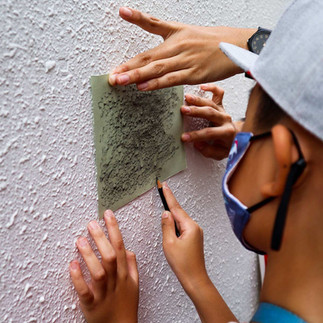Art Techniques You Should Use In Your Next Outdoor Art Experience
- Art Wonderland

- Oct 29, 2021
- 4 min read
Updated: Oct 30, 2021
What can be more exciting and immersive than experiencing art outdoors?
Over the September holidays this year, we conducted a holiday programme called 'The Nature Of A City' where we brought some of our kids out to explore the elements that existed in the urban and natural spaces of our city. From spotting the tiniest details on their favourite animals at the Singapore Zoo to scouting the different types of ginger plants present at the Singapore Botanic Garden, it was a perfect outlet to gather ideas and inspiration directly from observation. Instead of creating their artworks entirely inside the studio space, the kids experienced capturing different parts of the outdoor world using a variety of drawing techniques before coming back to work on their final outcome.
Here's a recap of the top three art techniques that were used when we explored the city:
1. Drawing from Observation

Also known as 'drawing what you see', observational drawing simply means to draw exactly what is portrayed in front of you. This could range anything from a person, an object or even a landscape. So long as the representation is a realistic portrayal, then you are on the right direction!
With observational drawing, the bulk of your time is taken to really study the subject. We had our kids to consider the various elements of art such as textures, shapes, shadows and even perspective when they used this technique. For the younger ones, encouraging them to break down the subject or object into simple shapes will help them to be more confident in drawing what is in front of them even if it is complicated.
The beauty of observational drawing is that you are taking your time and really looking at the smaller details, which would normally be overlooked. A common error made even by experienced artists, is drawing what you think you see, rather than what you are actually seeing.
This skill has so many benefits. Besides developing your drawing skills, it also improves accuracy and concentration!
2. Gesture Drawing
At this point, you might be wondering, how did the kids capture drawings of the moving animals then? Wouldn't that be slightly challenging?

That's where this other drawing technique called gesture drawing is applied. Unlike observational drawing, gestural drawing requires the artist to focus only on creating loose and suggestive lines when looking at a subject. What this means is that instead of using various elements of art to capture the form of a subject, very few lines are used to make up these drawings.

Notice how only simple lines are being used? We bet that you'd probably still be able to tell what animals they are!
In essence, gestural drawings can be done for any subject, but most typically for a moving form. They are known for their loose sweeping, sketchy lines that often are not precise, but is still able to capture the movement or essence of the form. They are a great way to learn how to quickly capture information, and to sometimes involve your whole body when you draw.
3. Frottage Technique

Do you remember taking a rubbing from a coin when you were little? That was a work of frottage!
Simply put, frottaging is the process of extracting impressions of an uneven surface through texture rubbings. This exciting technique can be used with a variety of mediums from pencils to crayons and even charcoal. Even rubbing on the same surface but in multiple, opposite directions will give you a different pattern.
Our kids had a blast looking for numerous surfaces that had unique and intricate patterns around the CBD. From the floor tiles of a shophouse to the concrete exterior of a heritage building, it's always captivating to watch how the different textures will emerge on paper.
This frottage technique is perfect for those who enjoy a more tactile approach to art making. Experiment with texture, play with the elements of composition and shape, try different mark making materials, and layer colours to create unique art pieces!
All in all, getting creative can be incredibly beneficial to our wellbeing. In these uncertain times we may not be able to travel or enjoy nature as we usually would, but art is a perfect outlet to celebrate the urban and natural environment in a different way. So the next time you head out for the outdoors, be sure to try out these simple art techniques and let us know which is your favourite!
Our Nature Of A City Holiday Programme is back for the End Of Year school holidays! Hop on over to our Peatix page to book your tickets. Only limited slots available.
Find out more about our children art programmes through our website. Follow us on our Facebook and Instagram pages to be in the loop for all the latest happenings.

About Iffah
Iffah believes in two-way communication of ideas when it comes to creative work. Growing up, the subject of Art/Design was taught passively; where there was little room for experimentation and self-exploration. Today, she aims to become the bridge that brings Art/Design to everyone, especially the young generation, to grow into critical and creative thinkers in order to fuel their passions.
















Comments